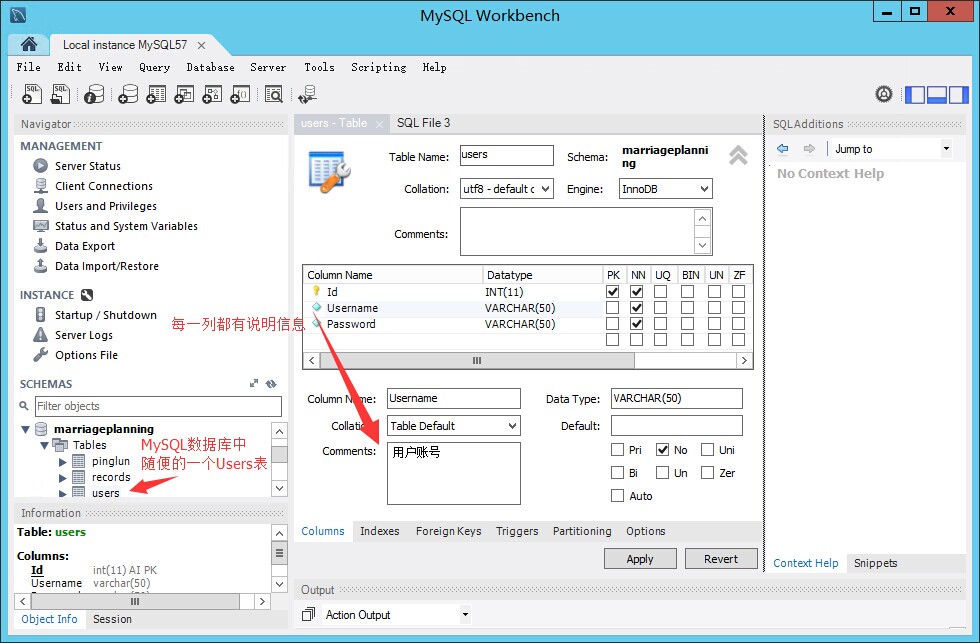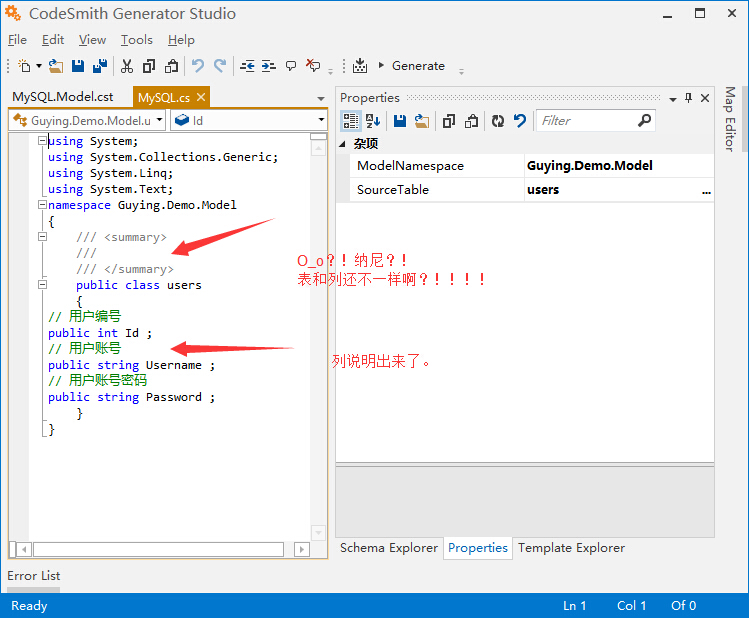问题描述:
CodeSmith是现在比较实用的代码生成器,但是我们发现一个问题:
使用CodeSmith编写MySQL模板的时候,会发现一个问题:MySQL数据表中的列说明获取不到,也就是column.Description。如图:

我们打开CodeSmith编写一个简单的Model实体类的示例模板如下:

<%-- Name: MySQL Model实体模板 Author: 孤影[QQ:778078163] Description: CodeSmith连接MySQL生成Model实体模板 --%> <%@ Template Language="C#" TargetLanguage="C#" ResponseEncoding="UTF-8" %> <%@ Assembly Name="SchemaExplorer" %> <%@ Import Namespace="SchemaExplorer" %> <%@ Property Name="SourceTable" Type="SchemaExplorer.TableSchema" Description="目标数据表" %> <%@ Property Name="ModelNamespace" Type="System.String" Description="Model实体所在的命名空间" %> using System; using System.Collections.Generic; using System.Linq; using System.Text; namespace <%=ModelNamespace %> { /// <summary> /// <%=SourceTable.Description %> /// </summary> public class <%=SourceTable.Name %> { <% // 循环遍历 获取当前数据表中的所有列 foreach(ColumnSchema column in SourceTable.Columns){ Response.WriteLine(string.Format("// {0}",column.Description)); Response.WriteLine(string.Format("public {0} {1} ;",GetCSharpVariableType(column),column.Name)); } %> } } <script runat="template"> // 获取指定列对应的C#数据类型 public string GetCSharpVariableType(ColumnSchema column) { if (column.Name.EndsWith("TypeCode")) return column.Name; switch (column.DataType) { case DbType.AnsiString: return "string"; case DbType.AnsiStringFixedLength: return "string"; case DbType.Binary: return "byte[]"; case DbType.Boolean: return "bool"; case DbType.Byte: return "byte"; case DbType.Currency: return "decimal"; case DbType.Date: return "DateTime"; case DbType.DateTime: return "DateTime"; case DbType.Decimal: return "decimal"; case DbType.Double: return "double"; case DbType.Guid: return "Guid"; case DbType.Int16: return "short"; case DbType.Int32: return "int"; case DbType.Int64: return "long"; case DbType.Object: return "object"; case DbType.SByte: return "sbyte"; case DbType.Single: return "float"; case DbType.String: return "string"; case DbType.StringFixedLength: return "string"; case DbType.Time: return "TimeSpan"; case DbType.UInt16: return "ushort"; case DbType.UInt32: return "uint"; case DbType.UInt64: return "ulong"; case DbType.VarNumeric: return "decimal"; default: { return "__UNKNOWN__" + column.NativeType; } } } </script> 一个简单的CodeSmith生成Model实体的模板
然后我们点击生成,生成的代码如下图:

当然,使用SQL Server及其他数据库都是可以获取到的,这是为什么呢?
逼的没招没招了的时候,果断打开.NET Reflector,看看CodeSmith对SQL Server和MySQL二者,数据表生成操作的时候,有什么不同的地方,或者有什么缺少的地方。
CodeSmith中对MySQL操作的DLL组件位置是:“X:\...\CodeSmith\v7.0\SchemaProviders\SchemaExplorer.MySQLSchemaProvider.dll”
展开后,开始一个个找里面的方法,突然发现一个亮点:“GetTableColumns(string connectionString, TableSchema table);”
这个字面的意思不就是获取列数据么?打开看看。。。可惜,里面只是根据表查询所有列,并没有Description相关操作。
继续找,继续对比。。。最终终于找到问题了:
方法“GetExtendedProperties(string connectionString, SchemaObjectBase schemaObject);”里面的查询语句是:
string str = string.Format("SELECT EXTRA, COLUMN_DEFAULT, COLUMN_TYPE FROM INFORMATION_SCHEMA.COLUMNS WHERE TABLE_SCHEMA = '{0}' AND TABLE_NAME = '{1}' AND COLUMN_NAME = '{2}'", schema.Table.Database.Name, schema.Table.Name, schema.Name);
这个不就是获取Column列中的扩展属性的方法么?!
对比发现,SQL Server的dll里这个方法的下面,有返回Description,而MySQL正好没有!
二话不说,找到CodeSmith的源码包解压,翻出MySQL的项目:“X:\...\CodeSmith\v7.0\Samples\Samples\Projects\CSharp\MySQLSchemaProvider”
然后打开Visual Studio载入"MySQLSchemaProvider.csproj",有很多错误,那是因为缺少了引用,添加CodeSmith\bin里面的相关引用即可。

需要引用的组件你可以在下面两个CodeSmith安装目录中找到:
“X:\...\CodeSmith\v7.0\bin\”、“X:\...\CodeSmith\v7.0\AddIns\”
添加引用之后,错误就全部没了:

然后我们果断开始修改代码、首先找到刚刚那个获取列扩展属性的方法:
“public ExtendedProperty[] GetExtendedProperties(string connectionString, SchemaObjectBase schemaObject)”
然后我们根据观察SQL Server的代码,发现MySQL里面这个方法:

在SQL语句查询的时候少查询了一项数据:“COLUMN_COMMENT”,于是我们首先修改它查询的SQL语句如下:
string commandText = string.Format(@"SELECT EXTRA, COLUMN_DEFAULT, COLUMN_TYPE, COLUMN_COMMENT
FROM INFORMATION_SCHEMA.COLUMNS
WHERE TABLE_SCHEMA = '{0}' AND TABLE_NAME = '{1}' AND COLUMN_NAME = '{2}'",
columnSchema.Table.Database.Name, columnSchema.Table.Name, columnSchema.Name);
既然上面查询了,按照正常的数据查询流程,下面应该遍历读取,然后返回吧?
于是继续看,下面有一个while,正是将上面查询出来的数据返回的,我们对比SQL Server的代码发现:

上面查询出来的每一项,下面都有获取返回,而我们刚刚添加的那个“COLUMN_COMMENT”则没有进行数据获取、没有怎么办?加呗~
获取每个数据后,最后统一将封装在“extendedProperties”中,于是我们也将获取到的Description添加进去,其与步骤省略。最终修改的代码如下:

public ExtendedProperty[] GetExtendedProperties(string connectionString, SchemaObjectBase schemaObject) { List<ExtendedProperty> extendedProperties = new List<ExtendedProperty>(); if (schemaObject is ColumnSchema) { ColumnSchema columnSchema = schemaObject as ColumnSchema; string commandText = string.Format(@"SELECT EXTRA, COLUMN_DEFAULT, COLUMN_TYPE, COLUMN_COMMENT FROM INFORMATION_SCHEMA.COLUMNS WHERE TABLE_SCHEMA = '{0}' AND TABLE_NAME = '{1}' AND COLUMN_NAME = '{2}'", columnSchema.Table.Database.Name, columnSchema.Table.Name, columnSchema.Name); using (DbConnection connection = CreateConnection(connectionString)) { connection.Open(); DbCommand command = connection.CreateCommand(); command.CommandText = commandText; command.Connection = connection; using (IDataReader reader = command.ExecuteReader(CommandBehavior.CloseConnection)) { while (reader.Read()) { string extra = reader.GetString(0).ToLower(); bool columndefaultisnull = reader.IsDBNull(1); string columndefault = ""; if (!columndefaultisnull) { columndefault = reader.GetString(1).ToUpper(); } string columntype = reader.GetString(2).ToUpper(); string columncomment = reader.GetString(3); bool isIdentity = (extra.IndexOf("auto_increment") > -1); extendedProperties.Add(new ExtendedProperty(ExtendedPropertyNames.IsIdentity, isIdentity, columnSchema.DataType)); if (isIdentity) { /* MySQL auto_increment doesn't work exactly like SQL Server's IDENTITY I believe that auto_increment is equivalent to IDENTITY(1, 1) However, auto_increment behaves differently from IDENTITY when used with multi-column primary keys. See the MySQL Reference Manual for details. */ extendedProperties.Add(new ExtendedProperty(ExtendedPropertyNames.IdentitySeed, 1, columnSchema.DataType)); extendedProperties.Add(new ExtendedProperty(ExtendedPropertyNames.IdentityIncrement, 1, columnSchema.DataType)); } extendedProperties.Add(new ExtendedProperty("CS_ColumnDefaultIsNull", columndefaultisnull, DbType.Boolean)); // Added for Backwards Compatibility. extendedProperties.Add(new ExtendedProperty(ExtendedPropertyNames.DefaultValue, columndefault, DbType.String)); extendedProperties.Add(new ExtendedProperty("CS_ColumnDefault", columndefault, DbType.String)); // Added for Backwards Compatibility. extendedProperties.Add(new ExtendedProperty(ExtendedPropertyNames.SystemType, columntype, DbType.String)); extendedProperties.Add(new ExtendedProperty("CS_ColumnType", columntype, DbType.String)); // Added for Backwards Compatibility. extendedProperties.Add(new ExtendedProperty("CS_ColumnExtra", extra.ToUpper(), DbType.String)); extendedProperties.Add(new ExtendedProperty("CS_Description", columncomment, DbType.String)); } if (!reader.IsClosed) reader.Close(); } if (connection.State != ConnectionState.Closed) connection.Close(); } } if (schemaObject is TableSchema) { TableSchema tableSchema = schemaObject as TableSchema; string commandText = string.Format(@"SHOW CREATE TABLE `{0}`.`{1}`", tableSchema.Database.Name, tableSchema.Name); using (DbConnection connection = CreateConnection(connectionString)) { connection.Open(); DbCommand command = connection.CreateCommand(); command.CommandText = commandText; command.Connection = connection; using (IDataReader reader = command.ExecuteReader(CommandBehavior.CloseConnection)) { while (reader.Read()) { string createtable = reader.GetString(1); extendedProperties.Add(new ExtendedProperty("CS_CreateTableScript", createtable, DbType.String)); } if (!reader.IsClosed) reader.Close(); } if (connection.State != ConnectionState.Closed) connection.Close(); } } return extendedProperties.ToArray(); } 最终修改完成的“GetExtendedProperties”方法
然后我们F6生成一个修改后的dll组件"SchemaExplorer.MySQLSchemaProvider.dll"。
找到默认的dll:“X:\...\CodeSmith\v7.0\SchemaProviders\SchemaExplorer.MySQLSchemaProvider.dll”,替.....不行,还是先备份一下。。。哈哈
然后替换。打开重启CodeSmith,再次生成。。。-_-# 我去!这是在逗我么。

再次回到Visual Studio中仔细看看整个方法,最后发现。。服了。它的这个方法的判断逻辑是:
1 public ExtendedProperty[] GetExtendedProperties(string connectionString, SchemaObjectBase schemaObject)
2
3 {
4
5 List<要返回的东西>......
6
7 if(schemaObject 是一个 ColumnSchema)// 如果是一个列对象
8
9 {
10
11 // 这里面也就是我们刚刚改的,获取列说明部分的代码
12
13 }
14
15 if(schemaObject 是一个 TableSchema)// 完全没有注意下面的这个判断,如果是一个表对象!!!
16
17 {
18
19 // 这里也就是我们下面要动手脚的地方了。
20
21 }
22
23 }
废话不多说。直接上这个方法最终的代码:

public ExtendedProperty[] GetExtendedProperties(string connectionString, SchemaObjectBase schemaObject) { List<ExtendedProperty> extendedProperties = new List<ExtendedProperty>(); if (schemaObject is ColumnSchema) { ColumnSchema columnSchema = schemaObject as ColumnSchema; string commandText = string.Format(@"SELECT EXTRA, COLUMN_DEFAULT, COLUMN_TYPE, COLUMN_COMMENT FROM INFORMATION_SCHEMA.COLUMNS WHERE TABLE_SCHEMA = '{0}' AND TABLE_NAME = '{1}' AND COLUMN_NAME = '{2}'", columnSchema.Table.Database.Name, columnSchema.Table.Name, columnSchema.Name); using (DbConnection connection = CreateConnection(connectionString)) { connection.Open(); DbCommand command = connection.CreateCommand(); command.CommandText = commandText; command.Connection = connection; using (IDataReader reader = command.ExecuteReader(CommandBehavior.CloseConnection)) { while (reader.Read()) { string extra = reader.GetString(0).ToLower(); bool columndefaultisnull = reader.IsDBNull(1); string columndefault = ""; if (!columndefaultisnull) { columndefault = reader.GetString(1).ToUpper(); } string columntype = reader.GetString(2).ToUpper(); string columncomment = reader.GetString(3); bool isIdentity = (extra.IndexOf("auto_increment") > -1); extendedProperties.Add(new ExtendedProperty(ExtendedPropertyNames.IsIdentity, isIdentity, columnSchema.DataType)); if (isIdentity) { /* MySQL auto_increment doesn't work exactly like SQL Server's IDENTITY I believe that auto_increment is equivalent to IDENTITY(1, 1) However, auto_increment behaves differently from IDENTITY when used with multi-column primary keys. See the MySQL Reference Manual for details. */ extendedProperties.Add(new ExtendedProperty(ExtendedPropertyNames.IdentitySeed, 1, columnSchema.DataType)); extendedProperties.Add(new ExtendedProperty(ExtendedPropertyNames.IdentityIncrement, 1, columnSchema.DataType)); } extendedProperties.Add(new ExtendedProperty("CS_ColumnDefaultIsNull", columndefaultisnull, DbType.Boolean)); // Added for Backwards Compatibility. extendedProperties.Add(new ExtendedProperty(ExtendedPropertyNames.DefaultValue, columndefault, DbType.String)); extendedProperties.Add(new ExtendedProperty("CS_ColumnDefault", columndefault, DbType.String)); // Added for Backwards Compatibility. extendedProperties.Add(new ExtendedProperty(ExtendedPropertyNames.SystemType, columntype, DbType.String)); extendedProperties.Add(new ExtendedProperty("CS_ColumnType", columntype, DbType.String)); // Added for Backwards Compatibility. extendedProperties.Add(new ExtendedProperty("CS_ColumnExtra", extra.ToUpper(), DbType.String)); extendedProperties.Add(new ExtendedProperty("CS_Description", columncomment, DbType.String)); } if (!reader.IsClosed) reader.Close(); } if (connection.State != ConnectionState.Closed) connection.Close(); } } if (schemaObject is TableSchema) { TableSchema tableSchema = schemaObject as TableSchema; string commandText = string.Format(@"SHOW CREATE TABLE `{0}`.`{1}`", tableSchema.Database.Name, tableSchema.Name); using (DbConnection connection = CreateConnection(connectionString)) { connection.Open(); DbCommand command = connection.CreateCommand(); command.CommandText = commandText; command.Connection = connection; using (IDataReader reader = command.ExecuteReader(CommandBehavior.CloseConnection)) { while (reader.Read()) { string createtable = reader.GetString(1); extendedProperties.Add(new ExtendedProperty("TS_Description", createtable, DbType.String)); int engineIndex = createtable.LastIndexOf("ENGINE"); int commentIndex = createtable.LastIndexOf("COMMENT="); string tableDescription = reader.GetString(0); if (commentIndex > engineIndex) { tableDescription = createtable.Substring(commentIndex + 9).Replace("'", ""); } extendedProperties.Add(new ExtendedProperty("CS_Description", tableDescription, DbType.String)); } if (!reader.IsClosed) reader.Close(); } if (connection.State != ConnectionState.Closed) connection.Close(); } } return extendedProperties.ToArray(); } 最终的“GetExtendedProperties”方法
重新生成,替换。。。重启CodeSmith,链接MySQL生成。。。。必然果断Ok:

网上当然也有很多例子,不过都是只处理了列的说明,没有处理表的说明。
我这个处理表说明是通过截取已获得的CreateTableScript里面的数据,获取的表说明。







 浙公网安备 33010602011771号
浙公网安备 33010602011771号